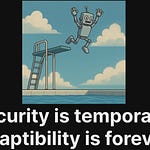(Like this article? Read more Wednesday Wisdom! No time to read? No worries! This article is also available as a podcast). You can also ask your questions to our specially trained GPT!)
Over in our sister publication Thursday Thoughts, an article was published called “Keeping it real about the European cloud”. This article discusses Europe’s dream for a “sovereign cloud”, which is much harder to realize than many people seem to think. Thursday Thoughts irregularly publishes articles that are longer and more opinionated. I would appreciate it if you would check it out and maybe subscribe.
Many, many years ago I was hanging out with some friends, one of whom was a basketball coach. We were randomly watching a soccer game where Egypt was playing some other African nation. After the game, the Egyptian team manager was interviewed and during that interview he said that the reason for their recent success was that he had changed the culture of the team. “This is the best coach on the planet”, my basketball coach friend said. “Because he managed to change the culture of his team…”
It is definitely true that culture eats strategy and tactics for breakfast. As I wrote before, I have a very simple definition of culture: It is “just” the sum total of what you do. If your entire team keeps their cameras off during team meetings, then that is your culture. If code reviews are just stamped without an actual review, that is your culture. If nobody says anything during the yearly feedback session on the employee happiness surveys, that is your culture. It might be a suboptimal culture; it might be in direct opposition of what you say your culture is, but still, what you do is your culture.
I have worked in companies that were very concerned about their culture changing. A common reaction to that is to talk about it a lot and maybe strengthen the language that describes what the “official culture” is. When that happens, there are often surveys, emails, special Slack channels, and “listening” sessions. One company I was at even instituted a “Culture Club”, apparently entirely oblivious to the fact that we’ve already had one and truly it wasn’t very good, so I wondered why they thought it would work this time. They also instituted a “Culture Czar”, because maybe what the culture needed was an autocratic ruler who could decide over the life and death of the workers at a whim’s notice.
All of this was of course useless; most cultural changes in growing companies are due to corporate gravity and I don’t think there is anything you are going to do about that.
Reading tip: Nobody escapes corporate gravity…
Changing the culture in smaller groups might be more achievable and indeed, I have managed on a number of occasions to do just that, which I guess puts me on par with the aforementioned Egyptian team manager.
Here is the key insight on how to achieve cultural change in a team: Show, don’t tell! And here is the somewhat obvious anti-pattern: Tell, but don’t show 🙂.
A few years ago, everyone who was anyone in Dutch politics was talking incessantly about the need for a “new political culture”: More transparency! More and better listening to grievances of Joe Sixpack and Ordinary Jane. And of course: Solutions that Work(™). A lot was said about the new political culture, but not a lot was actually done, and so nothing changed. If anything, the (then) new cabinet was depressingly old in its political culture, which I completely expected because the incentives hadn’t changed and hence nobody could afford to change their behavior.
Negative culture is incredibly contagious and people are always ready to jump over a low bar. If new people join the team and they notice that you get away with no unit tests, no meeting notes, and keeping your camera off during team meetings (so that you can play Diablo Immortal on your iPad), they will do just that. Bad team hygiene and suboptimal work practices spread like wildfire because it is just much easier to slack than it is to deliver high quality work which requires depressing consistency and attention to detail, both of which are tiresome.
To change that, you must first notice it. That’s the easy bit. But, what’s next?
As I wrote about before, we are always ready to assume that when things don’t go as we want them to, that is because of a lack of knowledge. And then what do we do? We add knowledge to the system. In the case of culture change: We talk about it, we write documents about it, and we give presentations about it. This course of action must be based on the expectation that, once we explain what the expected behavior is, people will start doing it. “Oh!”, people will suddenly think, “we need to write unit tests! That’s such a great idea! I will immediately start doing it.” Or: “Oh, when asked for a code review, we need to actually review the code and maybe make useful comments, suggestions, and spot potential bugs? How cool is that, who would have thought!?”
If you have ever been involved in any of these drives to improve unit test coverage, institute more effective code review, or improve oncall handoff, you probably know what will happen next. As we say in Holland: “Everyone took a leak and nothing had changed by the next week.”
Thanks to ChatGPT for translating this gem: “Iedereen doet een plas en alles is weer zoals het was”.
Telling people what to do does not work unless it is immediately followed by a change in incentives. For the kinds of things we want to change in a team’s culture that is typically not going to happen, though sometimes it is possible. During Google’s phase of explosive hiring, every engineer was expected to do at least one interview per week. That was always a bit of a struggle until Google’s SVP Urs Hölzle instituted changes in the bonus program and job ladder that would negatively impact anyone who did not carry their weight vis-à-vis the interview load. Cue lots of “enthusiasm” to do interviews. The same happened with doing more grunt work; Urs (again) made it an explicit part of the job ladder to do grunt work and that did wonders for the amount of technical debt that was addressed. Changes in incentives at that level are rare though, and they are especially rare for things that are only impactful at a team level.
So if talking about change does not work and we do not have proper incentives in place, what to do instead? Answer: Model the desired behavior.
“Show, don’t tell” means that you need to actively model the behavior that you would like to see. Easy as that. Do you want the team to do better code reviews? Make sure your code reviews are awesome! Want everyone to turn their camera on during video conferences? Start by turning your camera on. Want people to write better oncall handover notes? Write awesome oncall handover notes yourself! And then keep doing it (which might be a long time, but I am running ahead of myself a bit).
There are two problems with bringing change about through “show, don’t tell”. First: It takes a long time to bring about the change you want. Second: During a lot of that time, you look like a lone nutcase.
With respect to the first point: Kinda sucks, but there is nothing to be done about it. Depending on the thing you want to change, it might take months before you get any traction. A good Culture Czar could crack the whip and send some team members to the gulag, which has a tendency to focus the minds a bit, but for the lone nutcase who is doing a great job, you need to set an expectation for yourself that you will be alone for quite a bit while trying to set a good example.
Here is another great Dutch saying that might describe your emotions during that period: “Delivering quality in this organization is like peeing in your pants while wearing dark trousers; it gives you a warm feeling, but nobody notices.
So how and when will you get traction? When will you stop being the lone nutcase? At this point in the article, you need to stop reading and spend three minutes of your life watching this video. I promise it will be worth it…
Elevator music while you are watching the video
As the video shows, while you are modeling the expected behavior, you probably look like a lone nutcase, but the moment the first follower joins, you get a movement going! This means that while you are modeling the behavior and showing everyone how it is done, you should actively seek out your first follower, acknowledge them (very important), and continue to do whatever it is that you were doing, but now together. There are undoubtedly people in your team who agree with you that the particular change that you want to bring about is necessary, but they might feel too new, too junior, or too <whatever> to take the lead.
Remember your high school dances? It’s not that people don’t want to dance, most people just hate being the first one on the dance floor. That is where you come in! You can take the lead, thereby lowering the bar for the people who agree with you to engage in that behavior too. Then, the first follower joins, and then the second. Now you have momentum! Eventually, even the stragglers will join and finally the people who do not agree with you are forced to join or risk being left behind.
As the video I referred to clearly shows, it is the first follower who turns the leader from a lone nut into something that can grow into a movement. The good thing about this insight is that you can be just as instrumental in bringing about change by being that first or second follower! If you spot some behavior you like and you want to embrace it, just copy it! You don’t (always) have to come up with the bright ideas; being able to spot someone else’s bright ideas and then copy them is just as important.
As I wrote above, the problem with “show don’t tell” is that it might take a long time to bring about the changes you want. Unfortunately, there is nothing that can be done about that. Inertia is one of the most important properties of matter and people are incredibly good at it. If you want to move a group of people into a certain direction, you need to apply consistent force. But, that also means that if you do manage to bring the change about, it will often stick, because once people do a certain thing, they often continue doing that thing, especially if they know in their heart of hearts that it is the right thing to do.
Bringing about change requires a leader to start modeling the desired behavior and then a first follower to turn it into a movement. You can be either. Don’t despair when your good behavior is not immediately copied. Find and nurture your first follower. And if you see behavior worth copying, be that first follower and start a movement. And remember this: The first follower is also a leader.











